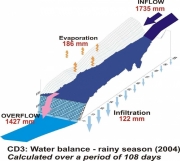The presentation by ACWADAM deals with a case study of augmenting groundwater resources by artificial recharge in Kolwan valley, Mulshi taluka, Pune. The DfID funded project was undertaken by the British Geological Survey in collaboration with its partners in India from 2002–2005. The objectives of the study were:
- Improved knowledge of the impacts of managed aquifer recharge in different physical and socio-economic settings.
- Guidance on scope and effectiveness of managed aquifer recharge for implementers, funders and policy makers.
- Dissemination of knowledge.
The Walki river basin with an area of 71 sqkm popularly known as Kolwan valley is largely representative of the hydrogeological conditions in Deccan basalt. The sequence of basalt lavas in the basin shows alternate units with vertical and horizontal jointing patterns traversed by regional fracture zones or dykes. It is marked by recharge initiatives through watershed development programmes. Various dimensions of artificial recharge like scientific, social and economic aspects were captured through this study.
The geological setting of the study area is dominated by Deccan basalt and the groundwater resources accumulation and movement is controlled by: (a) lithology (type of basalt), (b) degree of weathering and (c) nature and intensity of openings (joints, fractures, contacts etc.).
The site for detailed monitoring was Chikalgaon watershed and entailed detailed monitoring of a check dam. This was done through (a) Contour surveys of structure (b) Vertical Electrical Soundings (c) Inflow (d) Stage height: Overflow (wet season) and Water level decay (post monsoon) (e) Observation bore hole drilling & logging and (f) Water levels in observation bore holes.
The monitoring framework for water balance in check dams comprised of All Weather Station, Chikalgaon; rectangular weirs & V notch to measure inflows; Stage recorders (transducer type) in check dam 3 (CD3) and staff gauge, to measure overflows (wet season) as well as decay in water level (dry season).
The study defines the conceptual model thus –
- An impermeable base defined by a portion of unjointed or sparsely jointed basalt.
- Sub-horizontal sheet joints well developed in the basalt close to the stream channels and tends to die out laterally towards the watershed.
- Average thickness of aquifer is estimated to be 20 m.

According to the study -
- It is estimated that there was a net infiltration of about 122 mm from CD3 during the wet season, i.e. June-Sept 2004
- Groundwater in the Deccan basalts appears to be very fresh and predominantly HCO3 in nature.
- The water does not have problems due to chemical contamination.
- All the major inorganic constituents in water are in the safe zone.
- However, most of the villages have problems of biological contamination due to open sanitation and poor hygiene.
This presentation is part of the training modules on planning, development and management of groundwater with special reference to watershed management programmes by ACWADAM. Please write to ACWADAM at acwadam@vsnl.net for sourcing these presentations.